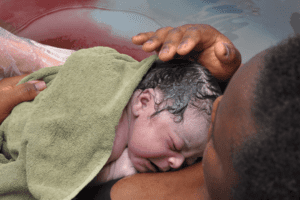Week-by-Week Pregnancy (Weeks 1-13)


1. Week 1-2
Even though you may not feel pregnant yet, your body is already going through huge transformations—long before your baby has even begun developing.
Pregnancy technically begins at implantation—when your fertilized egg implants into the wall of your uterus—which is usually about five days after fertilization.
However, the first two weeks are included in your overall pregnancy timetable, which is a total of 40 weeks—this includes fertilization. If you’re looking to calculate your due date, add 280 days to the date of when your last period began.
Read more about weeks 1-2.
Reviewed by Dr. Jen Lincoln, November 2018
2. Week 3
Many women don’t know they’re pregnant at this stage, because there are few symptoms this early and you haven’t missed any periods.
For some, though, ovulation may not have happened on time, while there may be some cramping or spotting during fertilization. This is around the time where your baby’s genetic code is set: 23 chromosomes each from mom and dad.
Even early on, doctors recommend women who are trying to get pregnant should act as if they already are, which means taking prenatal vitamins (generic ones are perfectly fine), plenty of sleep, and folic acid. Be sure to work out with moderate exercise a few times a week.
Read more about week 3.
Reviewed by Dr. Jen Lincoln, November 2018
3. Americord
4. Week 4
You’re not showing this early, but your hormone levels are already changing as estrogen and progesterone levels drastically increase around this time.
Weight gain during pregnancy is normal and healthy. While different for every mom, you only need to add about 300 extra calories a day to your current diet. Be sure to continue regular exercise, as it is great for both you and baby!
For women who weren’t planning on getting pregnant, this is around the time that they may suspect they are. Try to set up a prenatal appointment soon.
Read more about week 4.
Reviewed by Dr. Jen Lincoln, November 2018
5. Week 5
A lot is happening inside of your body right now, even though you outwardly aren’t “showing” yet. Most people who see you will have no idea you’re pregnant.
Symptoms may start around this time—like tender breasts, frequent urination, and exhaustion. Every woman experiences these differently, and they can range from slightly mild—even nonexistent!—to relatively severe. About half of all pregnant women experience nausea and vomiting early in their pregnancies.
If you’ve been feeling exhausted, it should go away as the weeks go on. Fatigue is normally just associated with early pregnancy.
Read more about week 5.
Reviewed by Dr. Jen Lincoln, November 2018
6. Week 6
If you’ve been experiencing morning sickness and regular fatigue, they will likely continue on this week.
You might have noticed some bloating, even though you aren’t showing yet, and chances are you’ve gained a few pounds. It may feel like you’re more than six weeks pregnant, since pregnancy hormones tend to make intestines lazy.
You should have had your first prenatal visit by now or schedule one soon. Decide if you’d prefer to be with a regular OB/GYN, a midwife, a family physician, or another type of obstetric provider as long as you feel they are a good fit for you and your pregnancy.
Read more about week 6.
Reviewed by Dr. Jen Lincoln, November 2018
7. Week 7
You should be taking your prenatal vitamin, folic acid, and getting plenty of calcium and iron. Be careful of the over-the-counter medications you’re taking for nausea. Some medications, like antacids and cold remedies containing iodine have been shown to interfere with nutrient absorption and baby’s normal development.
Many couples wonder how safe it is for women to have sex while pregnant. If you’re healthy and not considered a high-risk pregnancy, there is no need to stop having sex. And your baby will be fine—they are protected by the amniotic sac!
Read more about week 7.
Reviewed by Dr. Jen Lincoln, November 2018
8. Week 8
Welcome to the official two-month mark! Around this time you might feel cramping in your sides that are similar to menstrual cramps. This is normal and round ligament pain means your uterus and ligaments are stretching and growing to accommodate your baby.
Be cautious of bleeding around this time. While some spotting after sex or an exam is normal, heavy bleeding could signal a problem and you should contact your healthcare provider immediately. Roughly 20 percent of women will experience miscarriages and bleeding may be a sign. However, many women experience early bleeding and go on to have healthy babies.
Read more about week 8.
Reviewed by Dr. Jen Lincoln, November 2018
9. Week 9
During pregnancy, your blood volume will increase by as much as half. This is great for your baby and for you, as it provides extra protection against blood loss during labor.
Right now your baby leaves the “embryo” stage and has entered the “fetal” stage of development. You may even be able to hear your baby’s heartbeat, but don’t be upset if it’s not audible yet!
Unfortunately, first trimester symptoms will likely continue for the next few weeks, including morning sickness, fatigue, moodiness and cravings. The good news is that they should start to lessen as the first term ends.
Read more about week 9.
Reviewed by Dr. Jen Lincoln, November 2018
10. Week 10
You should be steadily gaining weight at this point, but not too quickly! Be sure to work on a healthy diet with whole grains, fruits, vegetables, and lean proteins.
If you haven’t gained any weight due to illness or morning sickness, don’t worry. It’s completely normal for some women not to gain any weight in the first trimester. But be sure to keep up a regular exercise routine, even if it’s just a morning or evening walk. It’s helpful to both you and your baby to stay active.
Right now your uterus is about the size of a grapefruit and still below your pubic bone. So while you may feel many changes in your body, they are still mostly hormonal, not physical.
Read more about week 10.
Reviewed by Dr. Jen Lincoln, November 2018
11. Week 11
You may start to show signs of a baby bump, but for some women, it may be a few more weeks before they start to show.
Around this time, you may start to experience an increase in appetite, which is different from your first-term pregnancy cravings. Now that your baby is growing at a rapid rate, your caloric needs are going to increase.
Keep in mind that your baby is protected inside the amniotic sac, so do not skip vital safety precautions, like wearing your seatbelt! And rest assured that if you don’t mind people touching your baby bump, they can! It is not harmful to the baby.
Read more about week 11.
Reviewed by Dr. Jen Lincoln, November 2018
12. Week 12
While it may seem like you’ve been pregnant forever—especially if you’ve experienced severe first trimester symptoms—many people may not be able to tell you’re even pregnant!
Right around this time, your uterus will start to relocate from the bottom of your pelvis to the front of your abdomen. Your uterus can expand to up to 1,000 times its pre-pregnancy size by the time your baby is born!
Inquire with your healthcare provider at your 12-week visit about screening for genetic disorders and other abnormalities. While a very personal decision, it is best to get all your questions answered!
Read more about week 12.
Reviewed by Dr. Jen Lincoln, November 2018
13. Week 13
This week is the last week of your first trimester! Congrats!
If you’ve experienced fatigue early on, many women say the second trimester is the “happy” trimester, when their mood and energy increase!
Be sure to continue your prenatal vitamins, regular exercise, and good diet routine. Expectant mothers only need an extra 300 calories as they “eat for two.” Gradual weight gain—instead of large amounts at once—actually lessen the chances of stretch marks. Rapid or excessive weight gain can make stretch marks worse.
Read more about week 13.
Reviewed by Dr. Jen Lincoln, November 2018
14. Second Trimester
Welcome to the second trimester! Want to know what is happening in week 14 and beyond? Check out the second trimester slideshow.
Reviewed by Dr. Jen Lincoln, November 2018
Powered by Bundoo®










































